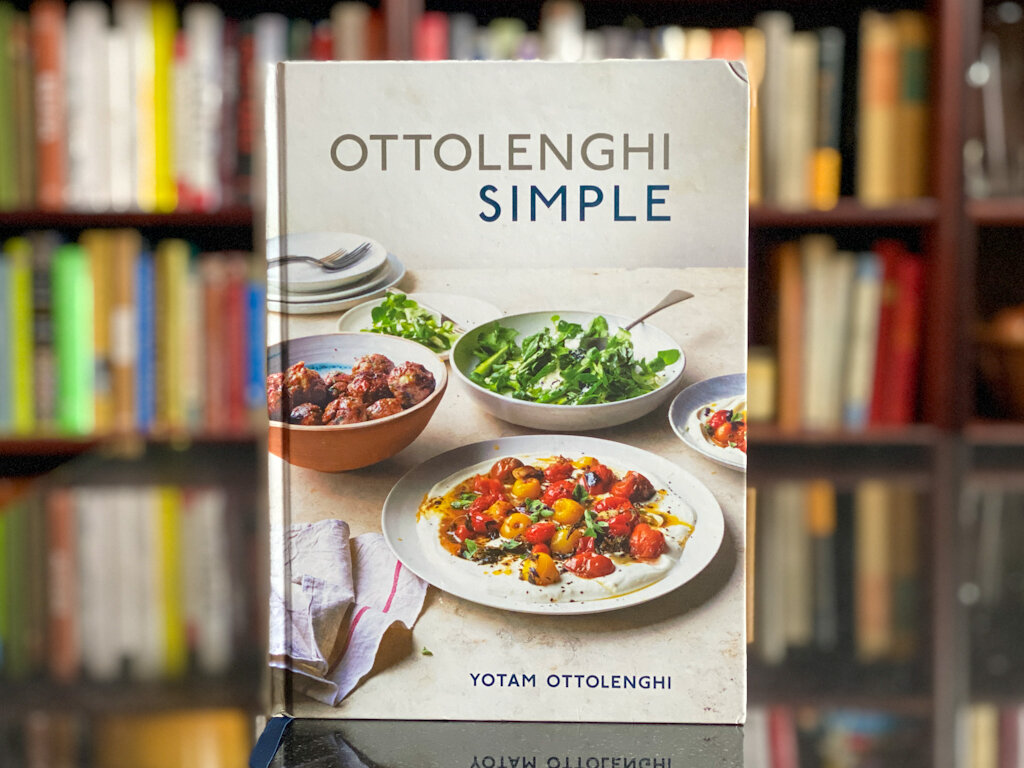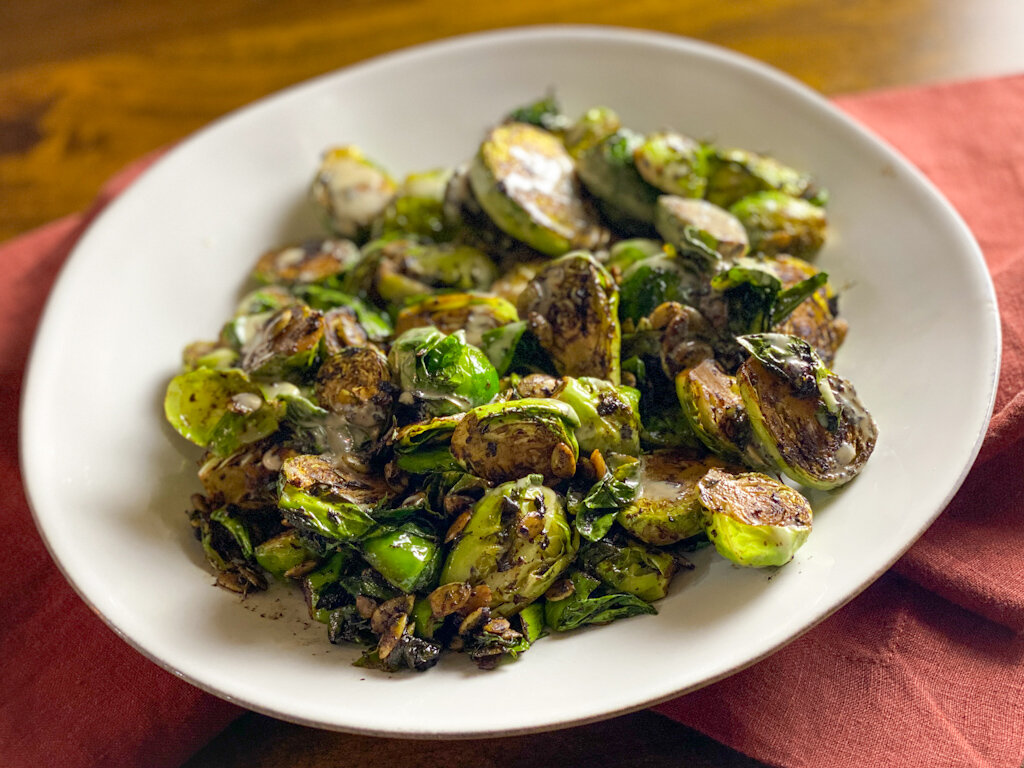By Leslie Brenner
Ottolenghi Simple, by Yotam Ottolenghi with Tara Wigley and Esme Howarth, photographs by Jonathan Lovekin, 2018, Ten Speed Press, $35.
Backgrounder: Unless you’ve been cooking under a rock for the last decade (or only started cooking recently), you probably know who Yotam Ottolenghi is. The London-based, Israeli-born chef probably has had greater influence than any other in the world on contemporary American (and other Anglophone) cooking in the last decade. His kind of free-form, casual, herb-strewn, plant-based (whether vegetarian or vegan or not), sun-kissed, Mediterranean-inflected aesthetic informs the creative endeavors of cooking writers, chefs and recipe developers for mainstream generalist sites like New York Times Cooking or Washington Post Voraciously, as well as a generation of cooking bloggers, restaurant chefs and Instagram posters. If formal, carefully arranged, tweezer-food plates feel out-of-date, it is largely thanks to Ottolenghi.
Ottolenghi’s first title, Ottolenghi: The Cookbook — co-written with his business partner, chef Sami Tamimi, was published in Britain in 2008, followed by Plenty (2010); Jerusalem (2012, again with Tamimi); Plenty More (2014); Nopi (2014, with Ramael Scully); Sweet (2017, with Helen Goh); Ottolenghi Simple (2018, with Tara Wigley and Esme Howarth); and Ottolenghi Flavour (or Flavor, for the U.S. edition, 2020, with Ixta Belfrage and Tara Wigley).
Puy lentils with eggplant, tomatoes and yogurt from ‘Ottolenghi Simple’
Why we love it
Simple may not be as exciting or groundbreaking as Plenty or Jerusalem were when they were published (they are still two of my favorite cookbooks), but it is packed with an astounding number of recipes we want to cook over and over again, as well as recipes we can’t wait to try. As with his other books, the recipes work; rarely is there anything about them I’d change or tweak. Yet unlike many of his other books, these recipes are do-able by ordinary cooks who don’t want to chase down a long list of obscure ingredients or start preparing sub-recipes the day before you want to eat.
Most are designed to be simple enough so that you can achieve them on a busy weeknight — which is a big part of why the book is so incredibly appealing. It’s a book for the way so many of us want to eat — we want dishes that are delicious, plant-forward, interesting, healthful, satisfying and unfussy, and that’s what this book delivers, over and over again. If you keep a few key ingredients in your pantry (things the author calls “Ottolenghi Ingredients” — sumac, tahini, preserved lemon, black garlic and za’atar, to name half of them), plus staples like yogurt and green lentils and basic seasonal produce, you can often pull together these dishes without making a special shopping trip. Other times, there’s an easy swap you can make, if, for instance, you don’t have the suggested herb.
Two cases in point
Puy Lentils with Eggplant, Tomatoes and Yogurt (pictured above) is fabulous garnished with the fresh oregano leaves it calls for, but I’ve also subbed in parsley, mint or cilantro when I didn’t have any oregano, to delicious effect. I’m sure basil would be great as well.
And for a dish of Chickpeas and Swiss Chard with Yogurt, Ottolenghi grants permission in the headnote to leave off his suggested cilantro garnish should you find yourself without. The night I made it — entirely pulled together from stuff I had on hand — parsley and mint did the trick perfectly. The dish is the kind of satisfying and interesting main course I’m always wishing for on days when I want to do without meat. That night, I happened to whip it together to go with a dish my son Wylie had spotted and was making also from Simple — Lamb and Pistachio Patties with Sumac Yogurt Sauce. Both were wonderful.
You’ve gotta try this
Brussels Sprouts with Browned Butter and Black Garlic. When I spotted packages of black garlic (intensely umami-forward fermented garlic) at my supermarket a few weeks ago, I grabbed one; it lasts for two or three months unopened. Then, the other day when I was trying to imagine how not to be bored by the pound of Brussels sprouts I’d envisioned for that evening, I found this exciting-looking recipe in Simple. Fortunately I happened to have some pumpkin seeds and caraway seeds (of course those are easy to find). The dish was brilliantly quick to prepare: a 10-minute roast in a blazing oven, followed by a toss with browned butter and a quickly made paste of black garlic, caraway seeds and thyme. A big squirt of lemon juice, a drizzle of tahini and dinner is served. It was insanely good.
Maybe you’ve already tried this — Stuffed Zucchini with Pine Nut Salsa. We wrote about it last summer in a story about zucchini. I’ve also made and loved more dishes than I could fit in this story: Cucumber and Lamb’s Lettuce Salad; a mezze spread called Crushed Zucchini; Roasted Eggplant with Anchovies and Oregano.
On a sweet note
I wanted to try one of the twelve great-looking desserts in the book, but for every one I was missing an ingredient. (I’ve been snowed in for four days!). I baked a Blueberry, Almond and Lemon Cake from the book anyway, subbing in a bag of frozen wild blueberries and I had for the fresh ones. It was a treat, but I think it’ll be even better with fresh berries, as the frozen ones were a bit dull. Stay tuned for an update once the ice melts. Come summer, I’ll be excited to make his Plum, Blackberry and Bay Friand (a friand is a light almond cake that the headnote tells us is popular in Australia, New Zealand and France).
Also still wanna cook
Most of the book! The minute it’s asparagus season, I’ll make Roasted Asparagus with Almonds, Capers and Dill. And I covet Cavolo Nero with Chorizo and Preserved Lemon; Cauliflower, Pomegranate and Pistachio Salad; Roasted Baby Carrots with Harissa and Pomegranate; Roasted Beets with Yogurt and Preserved Lemon; Orzo with Shrimp, Tomato and Marinated Feta; Pasta with Pecorino and Pistachios; and Lamb Siniyah — “the Middle Eastern equivalent of a shepherd’s pie, with a tahini crust standing in for the layer of mashed potato.”
Do yourself a favor. If you don’t have this book, and these are the kind of dishes that appeal to you, treat yourself to a copy today. Flavor has been getting lots of great press — and it’s a good book — but the recipes don’t scream “cook me” (in my ear, anyway!) as loudly as they do in Simple.
Did you enjoy this story? Read about who we are and what we do.
Try these, too!
RECIPE: Zahav’s Quinoa, Pea and Mint Tabbouleh
RECIPE: Half Whole-Wheat Pita Bread
RECIPE: Ultimate Hummus
RECIPE: Moussaka for the Ages




